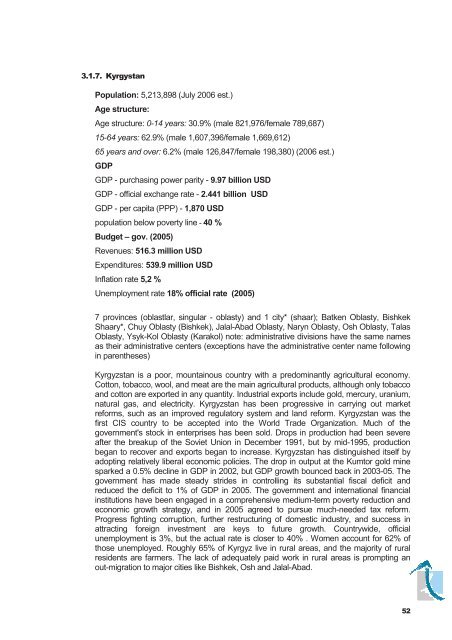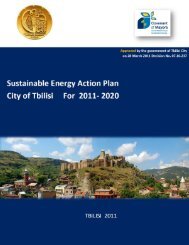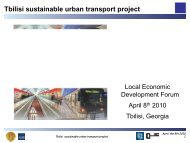LOCAL ECONOMIC DEVELOPMENT PLAN FOR TBILISI ... - LED
LOCAL ECONOMIC DEVELOPMENT PLAN FOR TBILISI ... - LED
LOCAL ECONOMIC DEVELOPMENT PLAN FOR TBILISI ... - LED
Create successful ePaper yourself
Turn your PDF publications into a flip-book with our unique Google optimized e-Paper software.
Population: 5,213,898 (July 2006 est.)<br />
Age structure:<br />
Age structure: 0-14 years: 30.9% (male 821,976/female 789,687)<br />
15-64 years: 62.9% (male 1,607,396/female 1,669,612)<br />
65 years and over: 6.2% (male 126,847/female 198,380) (2006 est.)<br />
GDP<br />
GDP - purchasing power parity - 9.97 billion USD<br />
GDP - official exchange rate - 2.441 billion USD<br />
GDP - per capita (PPP) - 1,870 USD<br />
population below poverty line - 40 %<br />
Budget – gov. (2005)<br />
Revenues: 516.3 million USD<br />
Expenditures: 539.9 million USD<br />
Inflation rate 5,2 %<br />
Unemployment rate 18% official rate (2005)<br />
7 provinces (oblastlar, singular - oblasty) and 1 city* (shaar); Batken Oblasty, Bishkek<br />
Shaary*, Chuy Oblasty (Bishkek), Jalal-Abad Oblasty, Naryn Oblasty, Osh Oblasty, Talas<br />
Oblasty, Ysyk-Kol Oblasty (Karakol) note: administrative divisions have the same names<br />
as their administrative centers (exceptions have the administrative center name following<br />
in parentheses)<br />
Kyrgyzstan is a poor, mountainous country with a predominantly agricultural economy.<br />
Cotton, tobacco, wool, and meat are the main agricultural products, although only tobacco<br />
and cotton are exported in any quantity. Industrial exports include gold, mercury, uranium,<br />
natural gas, and electricity. Kyrgyzstan has been progressive in carrying out market<br />
reforms, such as an improved regulatory system and land reform. Kyrgyzstan was the<br />
first CIS country to be accepted into the World Trade Organization. Much of the<br />
government's stock in enterprises has been sold. Drops in production had been severe<br />
after the breakup of the Soviet Union in December 1991, but by mid-1995, production<br />
began to recover and exports began to increase. Kyrgyzstan has distinguished itself by<br />
adopting relatively liberal economic policies. The drop in output at the Kumtor gold mine<br />
sparked a 0.5% decline in GDP in 2002, but GDP growth bounced back in 2003-05. The<br />
government has made steady strides in controlling its substantial fiscal deficit and<br />
reduced the deficit to 1% of GDP in 2005. The government and international financial<br />
institutions have been engaged in a comprehensive medium-term poverty reduction and<br />
economic growth strategy, and in 2005 agreed to pursue much-needed tax reform.<br />
Progress fighting corruption, further restructuring of domestic industry, and success in<br />
attracting foreign investment are keys to future growth. Countrywide, official<br />
unemployment is 3%, but the actual rate is closer to 40% . Women account for 62% of<br />
those unemployed. Roughly 65% of Kyrgyz live in rural areas, and the majority of rural<br />
residents are farmers. The lack of adequately paid work in rural areas is prompting an<br />
out-migration to major cities like Bishkek, Osh and Jalal-Abad.
















